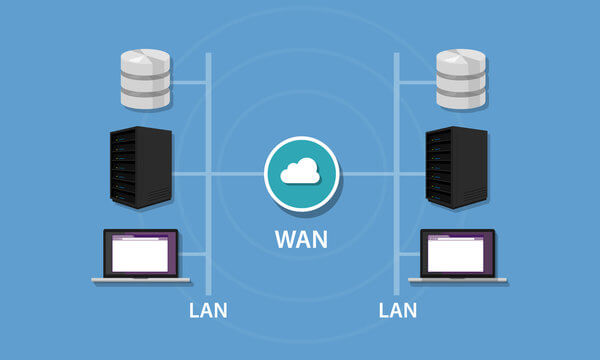
A network allows different computers to communicate with other computers by connecting over a medium. There are three major types of computer networks—WAN, MAN, and LAN—that are designed to operate within the area they cover. In this article, we will discuss the primary differences between LAN, MAN, and WAN. But before we do that, let’s take a look at each of them individually.
All three of them are similar yet differ in various aspects – the key difference is their coverage of geographical locations. WAN covers the largest area, MAN covers more area than LAN, and LAN covers only a smaller area.
Many other types of computer networks also exist, such as:
- Virtual Private Network (VPN)
- Enterprise Private Network (EPN)
- Storage Area Network (SAN)
- Personal Area Network (PAN)
What is LAN?
It is the short form of Local Area Network. It connects various network devices so that workstations and PCs (personal computers) can share programs, tools, and data. A single switch or a stack of different switches connects a group of different devices and computers. They use a private addressing scheme – defined by the TCP/IP protocol. The private addresses of each computer are unique concerning each other. At the border of each LAN, you’ll find routers that connect them all into one big WAN.
The rate of data transmission is very high because it connects to a very limited number of computers. These links exhibit high speeds and require cost-effective hardware, such as network adapters, hubs, Ethernet cables, etc. A LAN covers a very small area of about a few kilometers, and people own it privately for homes, office buildings, schools, hospitals, etc. It is much easier for people to design and maintain a LAN. The communication medium it uses consists of coaxial cables and twisted-pair cables. It also has minimal noise and error due to its short distance coverage.
Data rates in early LANs ranged from 4 Mbps to 16 Mbps. This speed today ranges from around 100-1000 Mbps. There is very little propagation delay in LAN. This usually relies on wired connections (to achieve better security and speed), but can also include wireless connections. The smallest LANs may use only two computers, and larger LANs can accommodate thousands of them. Users experience higher fault tolerance and less congestion in the LAN network (such as if a few students are playing together in the same room).
What is MAN?
It is the short form of the Metropolitan Area Network. It covers a smaller area than WAN and a larger area than LAN. A guy connects two devices (or more) that are separate but live in the same or different cities. It may also operate as an Internet Service Provider (ISP), and it covers a larger geographic area. Customers who need better speeds and higher-quality connectivity choose MAN. These are very difficult to maintain and design, and their speeds are in terms of megabytes per second (Mbps).
MAN shows low fault tolerance and high congestion in networks. It also exhibits moderate rates of data transfer and propagation delay. A single organization may or may not have one person, because it is too expensive. It uses devices like cables/wires and modems for data transmission. An important example of MAN is telephone company networks that can provide cable TV networks or high-speed lines (DSL) to customers in any city.
What is WAN?
It means a wide area network. It extends to large areas, but it may remain confined within the boundaries of a state or country. The connection of different LANs can also become a WAN. They can connect using radio waves and telephone lines. A WAN may generally be restricted to an enterprise (an organization or corporation) or may even be accessible to the general public. It has technology that is both high-speed and relatively expensive.
There are two types of WANs: point-to-point WANs and switched WANs. WAN is very difficult to design as well as maintain. Like MAN, fault tolerance is also very low, and this brings more congestion to the network. The communication medium deployed for WAN is a satellite link or public switched telephone network (PSTN). Normal long-distance transmission causes more error and noise in the WAN.
The data rate associated with a WAN is comparatively slower than that of a LAN – about one-tenth of its speed. This is due to longer distances to be covered and a higher number of terminals, servers, etc. Transmission speeds in a WAN can range from a few Kbps (kilobits per second) to Mbps (megabits per second). One of the biggest problems facing WANs is propagation delay. Some of the devices that help in data transmission through WAN are satellites, microwaves, and optic wires. An example of a point-to-point WAN is a dial-up line connecting any home computer to the Internet. An example of a switched WAN is the ATM (Asynchronous Transfer Mode) network.
Get Out the Best Course
Cisco CCNA 200-301 Course Online
CCNP (Encor and Enarsi) Online Training Course
CCNP Service Provider | Training and Certifications
CCIE Data Center | Online Course
Difference Between LAN, MAN, and WAN
| Parameter | LAN | MAN | WAN |
| Full Name | LAN stands for Local Area Network | Metropolitan Area Network is abbreviated as MAN. | WAN is the short form of Wide Area Network. |
| Definition and Meaning | A LAN is a network that connects a small group of computers, usually in a given geographic area. | MAN is a comparatively wide network covering large towns, cities, etc. | WAN networks span an even larger area. It can connect different countries. |
| Network Ownership | The LAN is private. Hospitals, homes, schools, offices, etc. can own it. | MAN can be both private and public. Several organizations and telecom operators may own them. | WAN can be both private and public. |
| Maintenance and Designing | Very easy to design and maintain. | Comparatively difficult to design and maintain. | Very difficult to design and maintain. |
| Speed | LAN provides very fast internet speed. | MAN provides moderate internet speeds. | WAN provides low internet speed. |
| Propagation Delay | It suffers minimal propagation delay. | It suffers from moderate propagation delay. | It suffers from high propagation delay. |
| Fault Tolerance | LAN has superior fault tolerance. | MAN exhibits low fault tolerance. | WAN also exhibits low fault tolerance. |
| Congestion | The network experiences minimal congestion. | This shows high network congestion. | This shows the highest congestion in the network. |
| Communication Allocation | LAN typically allows a pair of devices to establish communication. | MAN allows multiple computers to interact with each other simultaneously. | Using WAN a huge group of computers can easily interact with each other. |
| Uses | It covers a city, a small town, or any area with a larger radius than a LAN. | WAN networks span an even larger area. It has the ability to connect different countries. | This includes the entire country, subcontinent, or equivalent region. |
Conclusion
Local area network (LAN), metropolitan area network (MAN), and wide area network (WAN) are three different types of computer networks, which differ in their geographic coverage. At PM Networking, we help individuals and organizations understand these network types to make informed infrastructure decisions. LANs are designed for small areas, providing fast data transmission, low propagation delay, and high fault tolerance. MANs cover large areas, are suitable for cities, and exhibit moderate speed with low fault tolerance. On the other hand, WAN covers wider areas, connecting countries or even continents, but comes with lower Internet speeds, higher propagation delay, and lower fault tolerance. LANs are privately owned and easier to design and maintain, whereas MANs can be private or public, adding more complexity to maintenance. WANs, whether private or public, are challenging to design and maintain. Each network type serves specific purposes, providing tailored solutions for organizations ranging from homes and offices (LAN) to cities (MAN) and entire countries or regions (WAN).
How does latency differ among LAN, MAN, and WAN?
LANs have the lowest latency due to close proximity. MANs experience moderate latency, while WANs typically have the highest latency due to long-distance data transmission.
What career benefits come with completing a Cisco SD-WAN Online Course?
Completing a Cisco SD-WAN Online Course can open doors to job roles like SD-WAN Engineer, Network Automation Specialist, and Enterprise Network Architect in large-scale organizations.
Is Cisco SD-WAN suitable for hybrid or multi-cloud environments?
Absolutely. Cisco SD-WAN is designed for hybrid and multi-cloud deployments, offering seamless connectivity between on-premise systems and cloud platforms like AWS, Azure, and Google Cloud.
How does Cisco SD-WAN impact overall network efficiency?
Cisco SD-WAN reduces latency, automates failover, and optimizes bandwidth—significantly improving overall network performance. PM Networking emphasizes real-time monitoring and optimization strategies in its course.






0 Comments